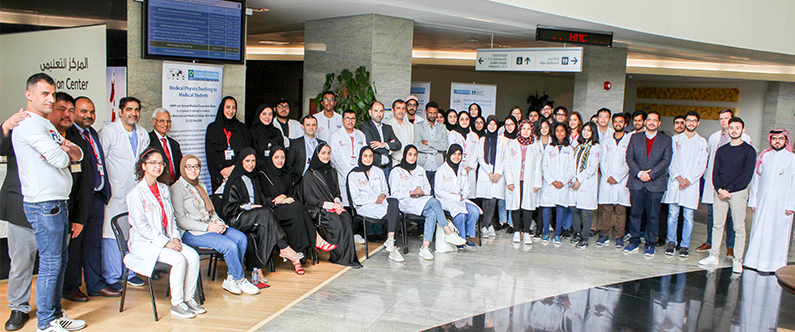Pre-med students explore medical physics in HMC training session
 WCM-Q first-year pre-medical students completed a two-day training session on medical physics offered by the Occupational Health and Safety (OHS) Department at Hamad Medical Corporation (HMC).
WCM-Q first-year pre-medical students completed a two-day training session on medical physics offered by the Occupational Health and Safety (OHS) Department at Hamad Medical Corporation (HMC).
Pre-medical students had the chance to learn about the role medical physicists play in the healthcare sector thanks to a two-day training session offered by the Occupational Health and Safety (OHS) Department at Hamad Medical Corporation (HMC).
Medical physicists play important roles within hospitals, working alongside doctors and other healthcare professionals to ensure the safety and effectiveness of radiological procedures and developing new medical technologies.
In total, 46 WCM-Q first-year pre-medical students completed the training session, which was organized in cooperation with HMC’s Occupational Health and Safety Department and Medical Education Department as well as the International Organization of Medical Physics, prior to the coronavirus outbreak and social distancing measures,.
Despite the importance of their role, the work of medical physicists usually goes on behind the scenes and is therefore not well known. The training session aimed to introduce the pre-med students to the key role played by medical physicists, explaining how they work closely with doctors on the diagnosis and treatment of patients, maintain and operate vital medical equipment, help devise treatment plans and take part in research and development of novel therapies and diagnostic techniques. As healthcare becomes more sophisticated and evidence-based, so the role of medical physicists is growing and becoming still more important.
Dr. Mohammad Yousef, associate professor of physics at WCM-Q, said: “Medical physicists play vital roles in the diagnosis and treatment of vast numbers of patients, but because a lot of their work happens away from the clinic it is difficult for students to appreciate just how important they are. This excellent training session helped our pre-medical students gain a very good understanding of the work that medical physicists do, both in terms of treatment and in research and development of new ways to deploy technology to provide better healthcare outcomes for patients. In addition, the sessions emphasized the relevance of physics education in medical school curricula. More and more medical disciplines are now integrated with advanced technology.”
Dr. Marco Ameduri, associate professor of physics and senior associate dean for pre-medical education and Education City collaborative curricular affairs at WCM-Q, said: “We are extremely grateful to the Occupational Health and Safety Department and the Medical Education Department at HMC, as well as the International Organization of Medical Physics, for providing this excellent and extremely worthwhile training session for our WCM-Q pre-med students. The students learned a great deal about this very important field of healthcare and gave us exceptionally positive feedback about the session.”
WCM-Q extends its sincere thanks to HMC’s Dr. Huda al Naemi, executive director of the OHS Department; Dr. Andrew Jeremijenko, senior consultant of emergency medicine; Dr. Noora al Hammadi, chairman of the Radiation Oncology Department; Dr. Antar Aly, research scientist; Dr. Adham Darweesh, senior consultant, Radiology Department; Dr. Ali Barah, senior consultant, Radiology Department; and Dr. Hadi Fayad, medical physicist, OHS Department. WCM-Q also thanks Dr. Madan Rehani, president of the IOMP.